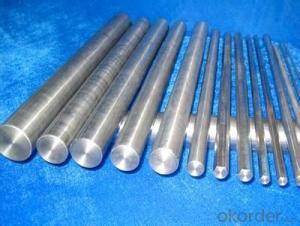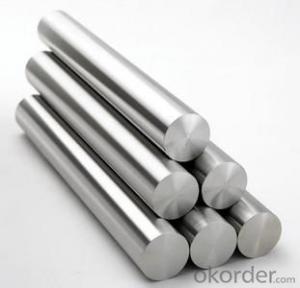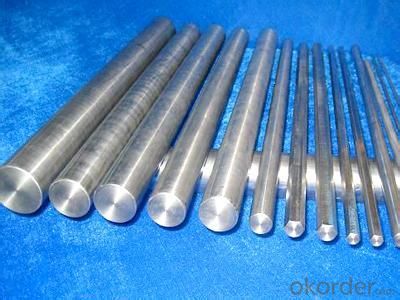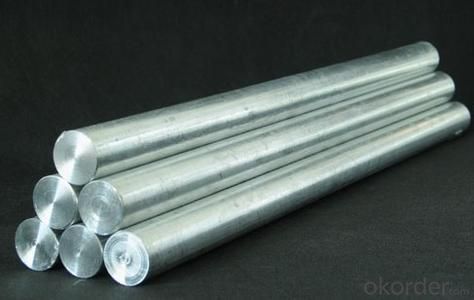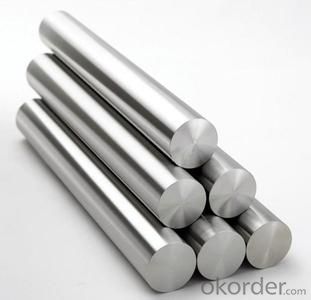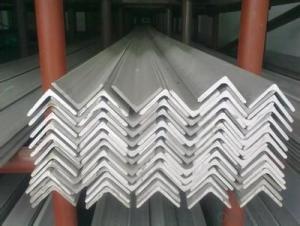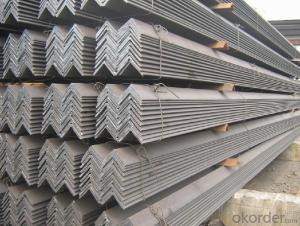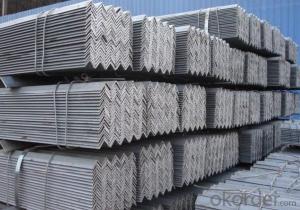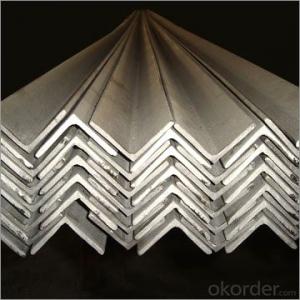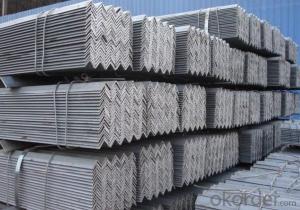Angle Steel Hot Rolled GB Q235 OR Q345 20MM-250MM
- Loading Port:
- China Main Port
- Payment Terms:
- TT or LC
- Min Order Qty:
- -
- Supply Capability:
- -
OKorder Service Pledge
OKorder Financial Service
You Might Also Like
Product Description:
OKorder is offering high quality Angle Steel Hot Rolled GB Q235 OR Q345 20MM-250MM at great prices with worldwide shipping. Our supplier is a world-class manufacturer of steel, with our products utilized the world over. OKorder annually supplies products to European, North American and Asian markets. We provide quotations within 24 hours of receiving an inquiry and guarantee competitive prices.
Product Applications:
According to the needs of different structures, Angle can compose to different force support component, and also can be the connections between components. It is widely used in various building structures and engineering structures such as roof beams, bridges, transmission towers, hoisting machinery and transport machinery, ships, industrial furnaces, reaction tower, container frame and warehouse etc
Product Advantages:
OKorder's Steel Angle Steel Hot Rolled GB Q235 OR Q345 20MM-250MM are durable, strong, and resist corrosion.
Main Product Features:
· Premium quality
· Prompt delivery & seaworthy packing (30 days after receiving deposit)
· Corrosion resistance
· Can be recycled and reused
· Mill test certification
· Professional Service
· Competitive pricing
Product Specifications:
Manufacture: Hot rolled
Grade: Q195 – 235
Certificates: ISO, SGS, BV, CIQ
Length: 6m – 12m, as per customer request
Packaging: Export packing, nude packing, bundled
Sizes: 25mm-250mm | ||||||||||||
a*t | ||||||||||||
25*2.5-4.0 | 70*6.0-9.0 | 130*9.0-15 | ||||||||||
30*2.5-6.6 | 75*6.0-9.0 | 140*10-14 | ||||||||||
36*3.0-5.0 | 80*5.0-10 | 150*10-20 | ||||||||||
38*2.3-6.0 | 90*7.0-10 | 160*10-16 | ||||||||||
40*3.0-5.0 | 100*6.0-12 | 175*12-15 | ||||||||||
45*4.0-6.0 | 110*8.0-10 | 180*12-18 | ||||||||||
50*4.0-6.0 | 120*6.0-15 | 200*14-25 | ||||||||||
60*4.0-8.0 | 125*8.0-14 | 250*25 | ||||||||||
FAQ:
Q1: Why buy Materials & Equipment from OKorder.com?
A1: All products offered byOKorder.com are carefully selected from China's most reliable manufacturing enterprises. Through its ISO certifications, OKorder.com adheres to the highest standards and a commitment to supply chain safety and customer satisfaction.
Q2: How do we guarantee the quality of our products?
A2: We have established an advanced quality management system which conducts strict quality tests at every step, from raw materials to the final product. At the same time, we provide extensive follow-up service assurances as required.
Q3: How soon can we receive the product after purchase?
A3: Within three days of placing an order, we will begin production. The specific shipping date is dependent upon international and government factors, but is typically 7 to 10 workdays.
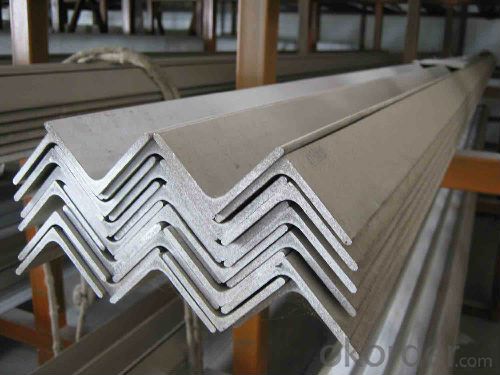
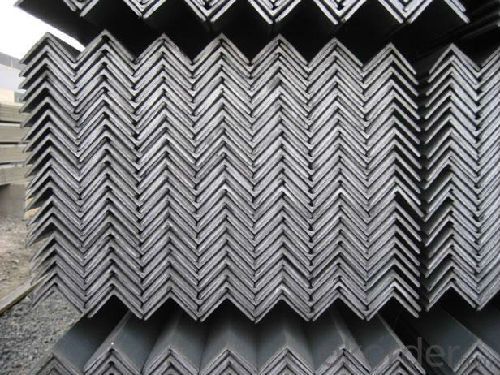
- Q: What is the difference between mill finish and hot-dip galvanized steel angles?
- Mill finish steel angles refer to angles that have undergone minimal processing after being formed, typically leaving a rough, dull surface. On the other hand, hot-dip galvanized steel angles have been coated with a layer of zinc through a process called hot-dip galvanization. This coating provides enhanced corrosion resistance, making galvanized angles suitable for outdoor and high-moisture environments.
- Q: Can steel angles be used in telecommunications towers?
- Yes, steel angles can be used in telecommunications towers. Steel angles are commonly used as structural components in the construction of telecommunications towers due to their strength, stability, and ability to withstand heavy loads. They provide the necessary support and stability required for the installation of antennas, equipment, and other telecommunications infrastructure.
- Q: Can steel angles be used in framing?
- Yes, steel angles can be used in framing. Steel angles are commonly used in construction for structural support and reinforcement. They are versatile and can be easily welded, bolted, or screwed together to create frames for various applications. Steel angles provide strength and stability to the structure and can be used in framing walls, ceilings, floors, and other structural components. Additionally, steel angles are available in different sizes and thicknesses, allowing for flexibility in design and construction. Overall, steel angles are a popular choice in framing due to their durability, versatility, and structural properties.
- Q: Can steel angles be used in earthquake-resistant construction?
- Yes, steel angles can be used in earthquake-resistant construction. Steel angles provide structural stability and strength and can be effectively utilized in earthquake-resistant designs to resist lateral forces and seismic loads. The rigidity and durability of steel angles make them suitable for reinforcing building frames and providing stability during seismic events.
- Q: Can steel angles be used for framing applications?
- Indeed, framing applications can utilize steel angles. The durability and strength of steel angles make them frequently employed in construction and framing. They offer structural support and stability for erecting walls, floors, and roofs. Furthermore, steel angles possess versatility, as they can be effortlessly welded, bolted, or screwed together to construct a robust and stable frame. Additionally, they are accessible in assorted sizes and thicknesses to cater to diverse framing necessities. All in all, due to their strength, durability, and user-friendliness, steel angles are widely favored for framing applications.
- Q: What are the common surface finishes for steel angles?
- There are several common surface finishes for steel angles, each serving a specific purpose and providing different aesthetic appeal. The most common surface finishes for steel angles include: 1. Hot-dip galvanizing: This process involves coating the steel angle with a layer of zinc, which provides excellent corrosion resistance. It is commonly used in outdoor applications where the steel angle is exposed to harsh environments or moisture. 2. Powder coating: Powder coating involves applying a dry powder to the steel angle and then curing it with heat. This finish provides a durable and attractive coating that is resistant to chipping, scratching, and fading. Powder coating is available in a wide range of colors and textures, allowing for customization. 3. Painting: Painting is a versatile surface finish option for steel angles. It can be done using various types of paint, such as epoxy, enamel, or acrylic, depending on the desired level of durability and aesthetic appeal. Painting provides protection against corrosion and can be easily customized with different colors. 4. Mill finish: This is the most basic surface finish for steel angles. It refers to the untreated surface that comes straight from the mill after manufacturing. Mill finish steel angles have a dark, rough appearance and are susceptible to corrosion. They are often used in applications where appearance is not a significant factor or when the steel angle will receive a subsequent surface treatment. 5. Stainless steel finish: Stainless steel angles have a natural resistance to corrosion due to their high chromium content. The surface of stainless steel angles can be left untreated, giving them a clean, sleek appearance. Alternatively, they can be polished to a mirror-like finish, providing a more decorative and attractive look. It is important to consider the intended use, environment, and desired appearance when choosing the appropriate surface finish for steel angles.
- Q: What is the maximum length for a steel angle?
- The maximum length for a steel angle can vary depending on the specific type and size of the angle, as well as the manufacturing capabilities of the steel supplier. Generally, steel angles are available in standard lengths ranging from 20 feet to 40 feet. However, longer lengths may be possible through custom orders or special production processes. It is recommended to consult with a steel supplier or manufacturer to determine the maximum length that is readily available or can be obtained for a specific type of steel angle.
- Q: Are steel angles resistant to high winds?
- Yes, steel angles are generally resistant to high winds due to their robust structure and strength. They are commonly used in construction and engineering projects to provide stability and support against strong winds.
- Q: Can steel angles be used as reinforcements in masonry walls?
- Yes, steel angles can be used as reinforcements in masonry walls. Steel angles are commonly used to provide additional strength and stability to masonry structures. They are often embedded within the mortar joints or anchored into the masonry units to enhance the overall structural integrity of the wall. The steel angles help to distribute and resist the forces acting on the wall, such as lateral loads or bending moments, making them a reliable choice for reinforcement in masonry construction.
- Q: How do you store and handle steel angles?
- Steel angles should be stored in a well-ventilated, dry area to prevent rusting. They should be stacked and supported properly to avoid distortion or damage. When handling steel angles, it is important to use appropriate lifting equipment and techniques to ensure safety. Additionally, they should be protected from scratches or dents during transportation and regular inspections should be conducted to identify any issues.
Send your message to us
Angle Steel Hot Rolled GB Q235 OR Q345 20MM-250MM
- Loading Port:
- China Main Port
- Payment Terms:
- TT or LC
- Min Order Qty:
- -
- Supply Capability:
- -
OKorder Service Pledge
OKorder Financial Service
Similar products
Hot products
Hot Searches
Related keywords
